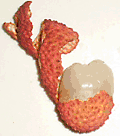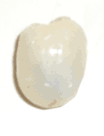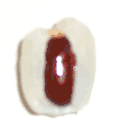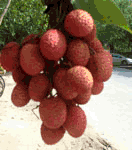The L. chinensis is a tropical type fruit tree native to low elevations of the provinces of Kwangtung and Fukien in Southern China. It is a slow-growing medium sized evergreen tree with dense, round-topped foliage, and smooth, gray, brittle trunk and branches. It may reach 40-50 feet height. Litchis, not only eye-catching in spring when the huge sprays of flowers adorn the tree but also is a stunning sight for nature lovers when the tree is full of berries.

|

|

|
| Lychee with outer peel. | Delicious litchi-pulp (flesh). | Lychee
fruit-interior. Note for dark brown color seed with smooth surface. |
In structure, the fruit is a drupe; oval, heart-shaped or nearly round, measures about 3–5 cm long and 3 cm in diameter and weigh about 10 g. In appearance, the fruit has close resemblances with longan and rambutan fruits.
Its outer surface is covered with rough leathery rind or peel featuring pink color. The peel can be easily removable in the ripe fruits. Inside; consists of edible portion or aril that is white, translucent, sweet and juicy.
The fruit has sweet, fragrant flavor and delicious to savor. The pulp has single, glossy brown nut-like seed, 2 cm long, and 1–1.5 cm in diameter. The seeds, like in sapodilla, are not poisonous but should not be eaten. Fresh lychees are readily available in the markets from July to October, about 120-140 days after flowering.
Health benefits of Lychee
-
Lychee fruits are low in
calories, contains no
saturated fats or cholesterol, but rich in dietary fiber, which, can be
very important for individuals who are concerned about their excess
body weight.
- Research studies suggest that oligonol, a low molecular weight polyphenol found abundantly in lychee fruit. Oligonol has been found to have several anti-oxidant, anti-influenza virus actions. In addition, it helps improve blood flow in organs, reduce weight, and protect skin from harmful UV rays (Takuya Sakurai (Kyorin University, Japan), Biosci. Biotechnol. Biochem., 72(2), 463-476, 2008).
-
Litchi, like citrus fruits,
is an excellent
source of vitamin C;
100 g fresh fruits provide 71.5 mg or 119% of daily-recommended value.
Studies suggest that consumption of fruits rich in vitamin C helps body
develop resistance
against infectious agents and scavenge harmful, pro-inflammatory free
radicals.
-
It is a very good source of
B-complex vitamins
such as thiamin, niacin, and folates. These vitamins are essential
since
they function by acting as co-factors to help body metabolize
carbohydrates, protein, and fats.
-
Litchi also contains a very
good amount of
minerals like potassium and copper.
Potassium is an important component
of cell and body fluids help control heart rate and blood pressure;
thus offers protection against stroke and coronary heart diseases.
Copper is required in the production of red blood cells.
Selection and storage

Lychee bunch. Fresh lychee fruits are available in the markets from June to October. The Fruit must be allowed to ripen fully on the tree itself since the ripening process stops soon after harvested. Overly maturity makes them turn dark-brown in appearance and lose their luster and flavor. While harvesting, snip off entire fruit brunch, keeping a short piece of the stem attached.In the store, choose fruits that feature fresh, without cuts or molds. Litchis have very good shelf life. Fresh fruits can be kept at room temperature for up to five days and can be stored for up five weeks in the refrigerator. They can also be frozen or dried and canned for export purposes.
http://www.nutrition-and-you.com/Lychee.html
No comments:
Post a Comment